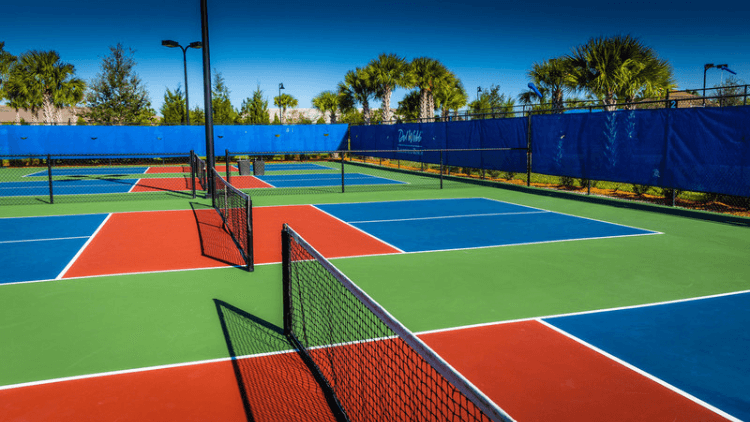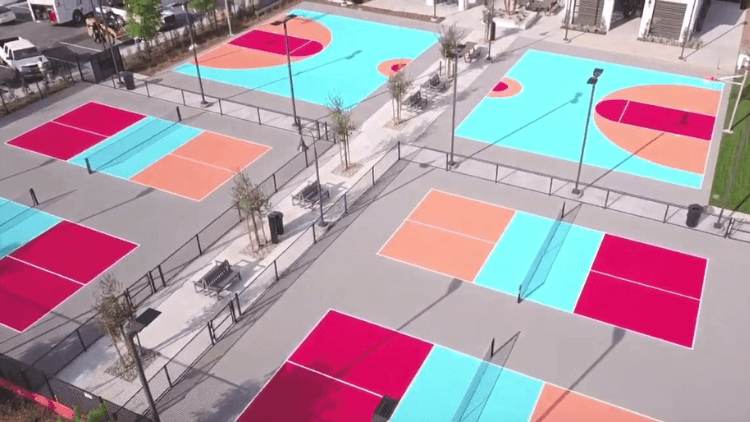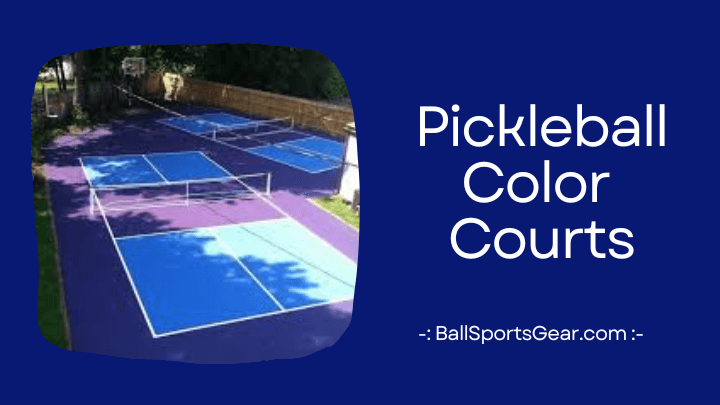Pickleball, which mixes aspects of table tennis, badminton, and tennis, is a fun and thrilling sport. It is played with a net, paddles, and a plastic ball on a court that is smaller than a tennis court. Pickleball may be played inside or outdoors and is appropriate for players of all ages and ability levels.
Choosing the appropriate colours for your court is one of the most crucial components of pickleball. The visibility of the ball, the players’ comfort, and the appearance of your property can all be impacted by the colours of your court. In this article, we’ll go through the fundamentals of official pickleball court colors and the things to keep in mind while making your selection, and how to paint your court with the colors you want.
Pickleball Court Colors: The Basics
A net divides the conventional pickleball court, which is 20 feet wide and 44 feet long, into two equal half. There are two service areas and a non-volley zone (also known as the kitchen) in each half. The non-volley zone is a 7-foot space on each side of the net where players are not permitted to smash the ball in the air. A line that is a component of the zone designates the non-volley zone.
The players’ preferences and the court’s location can influence the official pickleball court colors. To use different colours for the court, the non-volley zone, the lines, and the ball, however, is a general rule. This lessens eye strain and improves sight.
Some of the most common pickleball court colors are blue, green and red. These colors are bright and easy to see, and they also match well with most surroundings. However, you can also use other colors such as yellow, orange, purple or light gray. The main thing to remember is to choose colors that complement each other and create a clear contrast.
Here is a table that shows some recommended official pickleball court color combinations:
| Court | Non-Volley Zone | Ball |
|---|---|---|
| Blue | Green | Yellow |
| Green | Red | Orange |
| Purple | Yellow | Yellow |
| Light Gray | Red | Yellow |
Pickleball Court Colors: Factors to Consider
When choosing pickleball court colors, there are some factors to consider besides visibility. These factors include:

- Curb appeal: This refers to how well your court matches with the surrounding environment and property. You want your court to look attractive and inviting, not out of place or distracting. You can choose colors that blend in with your landscape, or colors that stand out and make a statement.
- Heat absorption: This refers to how much solar energy your court reflects or absorbs. Lighter colors tend to reflect more heat and keep your court cooler, while darker colors tend to absorb more heat and make your court hotter. This can affect the comfort of the players and the durability of the court surface. You may want to avoid very dark colors if you live in a hot climate or if your court gets direct sunlight for long periods.
- LEED credit: This refers to how environmentally friendly your court is. LEED stands for Leadership in Energy and Environmental Design, and it is a certification system for green buildings. Some pickleball court colors may qualify for LEED credit, which means they have low volatile organic compounds (VOCs), high solar reflectance index (SRI) or recycled content. You may want to choose these colors if you care about sustainability or if you want to save money on energy bills.
Pickleball Court Colors: How to Paint Your Court
You must paint your pickleball court in the colours you have chosen once you have made that decision. Although it is not particularly difficult, painting your court does take some planning and supplies. The procedures and supplies you’ll need to paint your pickleball court are listed below:
- Step 1: Prepare the surface. You need to make sure your court surface is clean, dry and free of cracks or holes. You can use a broom, a blower or a pressure washer to remove any dirt or debris. You can also use a crack filler or a patching compound to repair any damage on your surface.
- Step 2: Apply the primer. You need to apply a primer coat before applying the color coating. The primer helps the color coating adhere better and last longer. You can use a roller, a squeegee or a sprayer to apply the primer evenly over your surface. You need to let the primer dry completely before applying the color coating.
- Step 3: Put the coloured coating on. Two coats of colour coating must be applied to the surface. The colour coating is a particular type of paint made specifically for pickleball courts. It is long-lasting, anti-slip, and UV-resistant. The colour coating may be applied with the same tools as the primer. Before applying the second coat, the first coat must totally dry.
- Step 4: Denote the lines. You must designate your court’s lines in a different colour from your court and non-volley zone. The lines have to be 2 inches broad and distinct. To mark the lines, you can use a tape measure, chalk, or a stencil. To cover the sections you don’t want to paint, you may alternatively use masking tape or painter’s tape. To carefully and accurately paint the lines, you may either use a brush or a roller.
- Step 5: Guard your court. Your court has to be shielded from debris, moisture, and wear and tear. To put an additional layer of defence over your colour coating and your lines, apply a sealer or finish coat. To protect your court from rain or snow, you can also install a cover or tarp. It may take up to a week for your court to heal completely, so you should refrain from using it until then.

Frequently Asked Questions
A: The most common pickleball court colors are blue, green and red. These colors are bright and easy to see, and they also match well with most surroundings. However, you can also use other colors such as yellow, orange, purple or light gray.
A: Light colors tend to reflect more heat and keep the court cooler, while darker colors tend to absorb more heat and make the court hotter. This can affect the comfort of the players and the durability of the court surface. Light colors may also qualify for LEED credit, which means they have low volatile organic compounds (VOCs), high solar reflectance index (SRI) or recycled content.
A: You may build your own pickleball court colour schemes and view how they appear on your screen by using a court designer tool. To see how they seem in real life, you may also get some colour samples and apply them to a small portion of your court. You may also visit several pickleball courts that are already in place to see how the colours effect visibility and play.
Conclusion
Pickleball court colour selection may have a significant impact on both your game and your property. The visibility of the ball, the players’ comfort, and the appearance of your property can all be impacted by the colours of your court. You should pick hues that complement your preferences and demands, contrast effectively with one another and your ball, and are complementary to both.
You should now know more about pickleball court colours and how to choose them after reading this blog post, we hope. Please feel free to share your thoughts, queries, or experiences with pickleball court colours in the comments section below. Visit our website for additional details if you wish to play pickleball or find out more about it.

